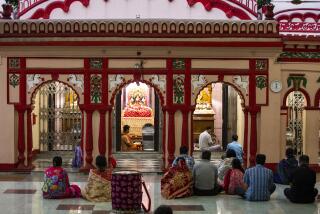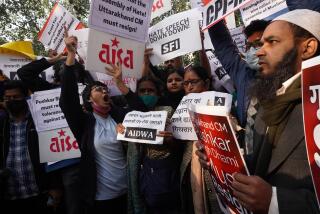Northeasterners’ exodus in India underlines power of social media
- Share via
NEW DELHI — The mass exodus from southern cities by thousands of panicked Indians returning to their homes in the country’s northeast in recent days has underscored deep social fissures in the country, the power of social media and the peril of weak political leadership, analysts said.
Hate messages and threats spread on social media last week after violence against northeasterners, sparking fear among tens of thousands from the region who have moved to major Indian cities in search of jobs and education.
Home Secretary R.K. Singh charged Saturday that many of the rumors that spread over the Internet originated in Pakistan.
“Morphed pictures, false messages were used to provocate people and trigger panic,” he told reporters. “A total of 76 websites were identified where morphed images were uploaded, and the bulk of these were uploaded in Pakistan.”
Also Saturday, the Central Bureau of Investigation, India’sequivalent of the FBI, announced a $2,000 reward for information leading to the arrest of those responsible for stirring up violence in the northeastern state of Assam, even as the exodus of northeasterners from the southern cities of Pune, Chennai and Hyderabad continued, albeit at a slower pace.
Northeasterners are often stereotyped by other Indians as the impoverished “other” and dismissed as uncivilized, violent exotics of questionable loyalty to the nation, said Babloo Loitongbam, founder of the civic group Human Rights Alert. “Then some trigger like this happens,” he said.
Bulk text messages have been banned for two weeks in a bid to stem rumors, and local, state and federal officials sought to calm frayed nerves and reassure those considering flight that they were safe and the situation was under control.
“This crisis shows you the power of social media” and the political vacuum allowing issues to spin out of control, said Sanjoy Hazarika, an analyst with New Delhi’s Center for North East Studies and Policy Research, a think tank. “The quality of India’s political leadership leaves much to be desired. The prime minister is almost invisible, most of the rest are involved in scams, the country has lost confidence.”
The roots of last week’s mass panic started in July when brutal sectarian violence broke out in Assam between Muslims and members of the minority Bodo tribe over land, jobs and political power. More than 75 people have been killed in tit-for-tat attacks and more than 300,000 people have sought shelter in displacement camps.
The eight states of India’s relatively isolated northeast, connected to the rest of the country by a small land bridge known as the “chicken’s neck,” have seen slower economic growth and more social problems. This often-ignored region of 42 million people has also suffered from insurgencies and infighting.
As New Delhi sought to contain the tension early in the week, Muslims staged a large demonstration in Mumbai, India’s financial capital, that saw two killed and dozens injured, bringing the issue to the heartland.
A few hours later, 10 northeasterners were badly beaten in neighboring Pune, allegedly by young Muslims inflamed by violent videos that purportedly showed attacks on Muslims in Assam.
Ethnic and regional groups migrating to India’s cities for jobs have long faced discrimination, and northeasterners are even bigger targets because of their distinct features and concentration in such industries as hotels, beauty parlors and restaurants, some said.
Initially, those jamming the transportation system to reach the perceived safety of their northeastern homeland were leaving large cities such as Chennai and Bangalore. But by week’s end, the exodus had spread to smaller cities such as Mysore and Mangalore, forcing railway authorities to add more trains.
Some said the government restrictions on text messages, known as SMS, miss the point. “Blocking SMS is stupid,” Loitongbam said. “People aren’t running away because of SMS. It’s because they perceive a real threat.”
On Friday, Prime Minister Manmohan Singh appealed for calm and pledged added security in a country that’s long suffered from sectarian and communal violence.
“What is at stake is the unity of our country,” Singh told Parliament. “We will do our utmost to ensure that our friends and our children and our citizens from the northeast feel secure in any and every part of the country.”
Analysts said the way rumors spread — or were fanned — on Facebook, Twitter and by text message, the resulting panic and the government’s clunky response underscored changes in information technology.
“One of the major problems is that our government doesn’t understand social media,” said Shubho Sengupta, who heads a digital media consultancy. “You have these guys 60-plus years old talking about Facebook. Our government is very reactive, knee-jerk, especially on social media.”
Analysts expressed hope that the crisis would shine a spotlight on a part of the country that has often been ignored, as well as on broader prejudice against minorities.
“There’s a basic vulnerability that people from the northeast feel in Indian cities,” Loitongbam said. “Let’s hope there are lessons learned.”
Tanvi Sharma in The Times’ New Delhi bureau contributed to this report.
More to Read
Sign up for Essential California
The most important California stories and recommendations in your inbox every morning.
You may occasionally receive promotional content from the Los Angeles Times.













